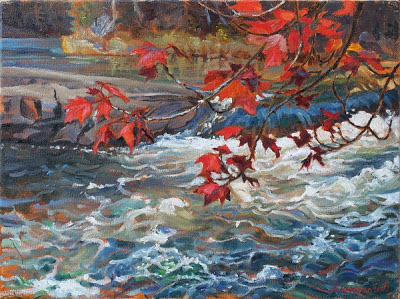Dryad's Saddle (oil on canvas, 5 x 7 in.) Sold

23 May finds me in a Manitoba Maple grove at a farmstead on Rt 100 in North Russell, Ontario, painting a Dryad's Saddle, Polyporus squamosus, bursting out of the rotting base of a tipped over Manitoba Maple. This is a fresh cap, 28 cm wide, with the usual two attendant younger caps beside it. Nearby another pair of young Polypores are poking out of a knothole on another nearly horizontal trunk. I sit on a short stool among the Nettles and the Jewelweed to paint, beginning with a dark, greyish-purple underpainting. Most of the mosquitoes are kept at bay by the wafts of three smoking insect coils.
Dryad's Saddle is a bracket fungus which plays an important role in woodland ecosystems by decomposing wood, but is occasionally a parasite on living trees, producing a white rot in the w. It ranges throughout North America east of the Rockies, and is also found in Europe and Australia.
Many of the Manitoba Maples in this grove are bent down. The stems which lean out towards the
lawns were cut off after the 1998 ice storm. Manitoba Maples could be called "plastic" trees - they don't have a characteristic shape because they're so breakable. They just grow up and out as best they can whenever their trunks lean or their branches break. Often horizontal branches rise up like trunks from an elbow, like the one I'm painting here. Manitoba Maples need lots of moisture. Like Willow trees, they grow along creeks and ditches, and doe so well around buildings, feeding on the dust-laden rain that runs off the roofs, that I think of them as trees that are comfortable around Humans. They grow fast into pleasant shade trees, but their rag-like autumn leaves are not easy to rake up, and their leaning trunks, prone to centre rot, can be dangerous when they fall. Lots of abandoned homesites are surrounded by Manitoba Maples that gradually decline as the nutrient sources associated with Human settlement are exhausted.
Many of the Manitoba Maples in this grove are bent down. The stems which lean out towards the
lawns were cut off after the 1998 ice storm. Manitoba Maples could be called "plastic" trees - they don't have a characteristic shape because they're so breakable. They just grow up and out as best they can whenever their trunks lean or their branches break. Often horizontal branches rise up like trunks from an elbow, like the one I'm painting here. Manitoba Maples need lots of moisture. Like Willow trees, they grow along creeks and ditches, and doe so well around buildings, feeding on the dust-laden rain that runs off the roofs, that I think of them as trees that are comfortable around Humans. They grow fast into pleasant shade trees, but their rag-like autumn leaves are not easy to rake up, and their leaning trunks, prone to centre rot, can be dangerous when they fall. Lots of abandoned homesites are surrounded by Manitoba Maples that gradually decline as the nutrient sources associated with Human settlement are exhausted.
The ground cover here is mostly Jewelweed, with some White Baneberry, patches of Nettle, leaves of Asters, and one dense mat of Yellow Violet with its charming leaves and pellet-like fruit - though much of the clay soil surface is bare, with twigs and fresh leaf fragments in place of any leaf litter. Creeping Charlie with pretty purple blooms, rambles across the ground. In the shade about the edges of the grove, big, shade-clone Dandelions grow. Fred measured one leaf as 10 cm across and 48 cm tall. These are similar to the Dandelions we used to have at home before the Honesty and Goutweed, and Bedstraw took over our grove. The shrubs here are Raspberry, Choke Cherry, and a few Red-berried Elder.
A Wood Peewee sings 'peeawee', and cascades of Thrush song echo in the woods beyond the swamp. The mosqitoes become more persistant as it becomes too dark to paint, and I pack up to the chucks and whistles of the omnipresent Robins. A few Spring Peepers begin to call at 20:37.
Fred notes that all the whispy Manitoba Maple leaves have been eaten up by worms over the fall and spring, and he didn't see any snail shells. He also found a dense four-metre seedling clump of Garlic Mustard and mapped a large patch of Lily-of-the-valley, Sweet Violet, Goutweed, and Shining (Frangulous) Buckthorn along the edge of the road in an area where garden waste is piled... all invasive species we also struggle against at home in Bishops Mills.



Comments
Post a Comment
What do you think of this painting, and what do you know about the subject that I have painted?